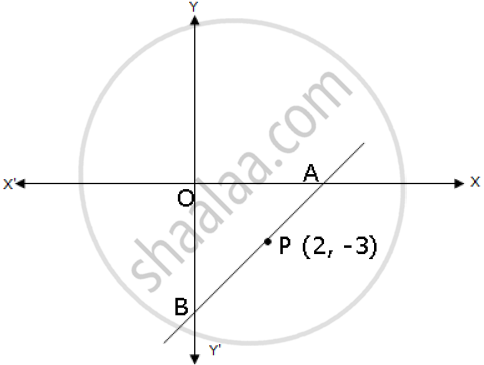Advertisements
Advertisements
प्रश्न
Angle made by the line with the positive direction of X-axis is given. Find the slope of the line.
45°
Angle made by the line with the positive direction of X-axis is 45°. Find the slope of that line.
उत्तर
Since Slope = tan θ
Here, θ = 45°
∴ Slope = tan 45°
Hence, Slope = 1
संबंधित प्रश्न
The slope of a line joining P(6, k) and Q(1 – 3k, 3) is `1/2`. Find:
- k.
- mid-point of PQ, using the value of ‘k’ found in (i).
A and B are two points on the x-axis and y-axis respectively. P (2, −3) is the midpoint of AB. Find the:
(1) coordinates of A and B
(2) slope of line AB.
(3) an equation of line AB.

Find the slope of the line parallel to AB if : A = (−2, 4) and B = (0, 6)
The side AB of an equilateral triangle ABC is parallel to the x-axis. Find the slopes of all its sides.

Find the slope and the inclination of the line AB if : A = (−3, −2) and B = (1, 2)
The points (−3, 2), (2, −1) and (a, 4) are collinear. Find a.
Find the value(s) of k so that PQ will be parallel to RS. Given : P(2, 4), Q(3, 6), R(8, 1) and S(10, k)
Find the slope and the inclination of the line AB if : A = `(0, - sqrt(3))` and B = (3, 0)
Find the slope of the line which is parallel to `x/2 - y/3 -1 = 0 `
Find the slope of the lines passing through the given point.
L (–2, –3) , M (–6, –8)
Determine whether the following point is collinear.
P(2, –5), Q(1, –3), R(–2, 3)
Show that the line joining the points A(4, 8) and B(5, 5) is parallel to the line joining the points C(2, 4) and D(1, 7).
Find the slope and the y-intercept of the following line 4y = 5x - 8
Find the slope and the y-intercept of the following line 2x + 3y = 12
Find the slope of the line passing through the points M(4,0) and N(-2,-3).
Find the slope of the line passing through the points A(4,7) and B(2,3).
Show that the line joining (2, – 3) and (- 5, 1) is:
(i) Parallel to line joining (7, -1) and (0, 3).
(ii) Perpendicular to the line joining (4, 5) and (0, -2).
If A(6, 1), B(8, 2), C(9, 4) and D(7, 3) are the vertices of `square`ABCD, show that `square`ABCD is a parallelogram.
Solution:
Slope of line = `("y"_2 - "y"_1)/("x"_2 - "x"_1)`
∴ Slope of line AB = `(2 - 1)/(8 - 6) = square` .......(i)
∴ Slope of line BC = `(4 - 2)/(9 - 8) = square` .....(ii)
∴ Slope of line CD = `(3 - 4)/(7 - 9) = square` .....(iii)
∴ Slope of line DA = `(3 - 1)/(7 - 6) = square` .....(iv)
∴ Slope of line AB = `square` ......[From (i) and (iii)]
∴ line AB || line CD
∴ Slope of line BC = `square` ......[From (ii) and (iv)]
∴ line BC || line DA
Both the pairs of opposite sides of the quadrilateral are parallel.
∴ `square`ABCD is a parallelogram.
Determine whether the following points are collinear. A(–1, –1), B(0, 1), C(1, 3)
Given: Points A(–1, –1), B(0, 1) and C(1, 3)
Slope of line AB = `(square - square)/(square - square) = square/square` = 2
Slope of line BC = `(square - square)/(square - square) = square/square` = 2
Slope of line AB = Slope of line BC and B is the common point.
∴ Points A, B and C are collinear.
